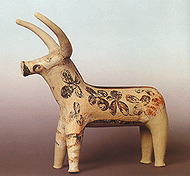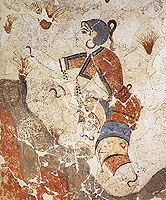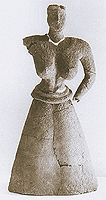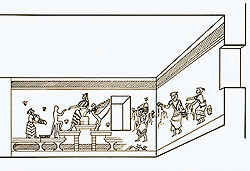



We have very few evidence on the existence of religious ceremonies during the Early Bronze Age, as areas with a particular arrangement or cult objects (figurines, ritual vases) have not been indicated in the architectural remains of this period. Nevertheless, the discovery of figurines in the Early Cycladic graves indicates that it could be interwoven with the burial customs. During the Middle Bronze Age the picture seems to change. In the settlement of Agia Irini on Keos a sanctuary, which will establish a long cultic tradition, is founded. In the beginning of its use, the cult in the sanctuary has a Minoan and Mycenaean character while during its mature phase it is completely identified with the Mycenaean cult. The influence of Central Greece on the sanctuary of Agia Irini and on that of Phylakopi are obvious mainly from the large number of cult figurines of Mycenaean type which are discerned in anthropomorphic zoomorphic. The zoomorphic figurines are usually goats or dogs while the anthropomorphic ones are distinguished according to their shape in Fi and Psi figurines, that is to say they observe with accuracy the shapes and types of the Mycenaean figurines. The large sized hollow-bodied figurines, the best-known of which is the so-called "Lady of Phylakopi", come from the the late phases of the sanctuaries. The information on the cult ritual is enrichened by the representations of the frescoes of Thera, many of which aimed at passing religious messages. As in the Minoan frescoes, the religious allusions of the representations are masterly harmonized with moments of everyday life and with naturalistic depictions of landscapes thus rendering the interpretation of the representations enigmatic. The language of the frescoes being somewhat incomprehensible, it is considered that the representations often depict persons taking part in sacred rituals. Among the scenes that are considered religious for certain is the scene of gathering the sacred crocus, in which the so-called "Saffron Gatherers" gather the sacred plant to offer it to a divine figure which is seated on a throne, flanked by griffins and monkeys. Cult scenes are also depicted on the Miniature Frieze with the fleet scene from the West House with a festive convoy theme. The "Springtime Fresco" may be related to fertility ceremonies while the young "boxers" were probably persons that participated in initiation ceremonies. A series of cult elements, such as the protagonistic role of the women, the flanking of Minoan sacred symbols and the initiation ceremonies suggest the cult customs of Minoan Crete. This indicates that apart from the Minoan influence in fields of material culture, the inhabitants of Thera had also adopted the cult ritual of the Minoan religion. |
 |
|
|
Keos, Agia Irini.
Clay female figurine from the sanctuary. Late Cycladic I-II period. |
||
 |
||
|
Thera, Akrotiri. Restoration of the fresco of the
"Saffron Gatherers" (after N. Marinatos).
|
||